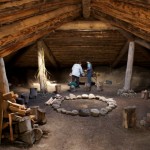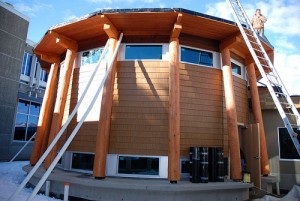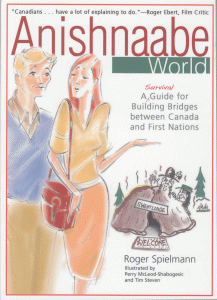Anishnaabe World: A Guide for Building Bridges
Our school district Cultural Coordinator has shared many resources with me over the years. One of the most recent was the book, Anishnaabe World: A Guide for Building Bridges between Canada and First Nations written by Roger Speilmann. This is an enjoyable and humorous read. Written in 2009 this survival guide includes chapters such as “Everything You Always Wanted to Know About Treaties (But Were Afraid To Ask)” and “Native Humour and Why Canadians Often Don’t Seem to “Get It””.
Roger and his family lived in Pikogan, an Anishnaabe community in northwest Quebec, for 11 years. All author royalties from this book are donated to the Native Students Association at Laurentian University.
This book has been held by many hands in our school district and gifted from one aboriginal support worker to another and then to me. I am wondering who I will next share it with.
December 4, 2011 No Comments
Attiwapiskatt – Just one of many.
With the country’s and world’s attention on the Attiwapiskatt reserve, do you feel that we are at a tipping point? How can we sustain the attention of our citizens and government to the issues of these struggling communities. Now that the Red Cross has moved in to one of our own communities in absence of flood, fire, earthquake . . . surely this must be a wakeup call? Perhaps we need to support the Red Cross so that the organization can afford to move into other communities. I don’t intend for my support to the red cross to take responsibility off of our government’s shoulders but to shame the government into action.
Those of you who are living outside of North America. Are you receiving much news of this situation? “The government continues to blame the victim.” Shameful! For those of you not living in Canada below are a couple of links.
Peter Mansbridge will have an extended interview airing this weekend on One on One with Shawn Atleo – the national chief of the assembly of first nations.
Eight minutes of the interview is shared on The National – 20:58 – of the broadcast.
http://www.cbc.ca/video/#/News/TV_Shows/The_National/1233408557/ID=2172409833 http://www.cbc.ca/video/#/News/TV_Shows/The_National/1233408557/ID=2172409801
December 4, 2011 No Comments
Van Sun – Truth & Reconciliation
Our school district cultural coordinator just shared this writing with me. Paul Kershaw of the Vancouver Sun wrote it and dated it November 17th of this year. I am uncertain as to whether or not it was published in the Vancouver Sun Newspaper.
“I encounter many non-aboriginal Canadians today who do not consider the Truth and Reconciliation Commission a priority. They claim the schools are part of our past, and doubt they have significance for the present.”
“By forcibly isolating children from the influence of their families and cultures . . . residential schools did not just target students. They also targeted generations of aboriginal people who would never attend them – the children and grandchildren of school survivors: the very future of aboriginal communities.”
(Kershaw, 2011)
I found this to be a concise and well organized read. I intend to share this work with our Aboriginal Inquiry group in the new year.
I have attached the paper for your convenience should you wish to read and/or share with others.
New Deal for Families promotes truth and reconciliation By Paul Kershaw,
Vancouver Sun – November 17, 2011
November 23, 2011 No Comments
Teachers’ Views on Western and Aboriginal Science
While researching for my ETEC 521 paper, I came across a tremendously interesting read. And it would so happen, this read fits in beautifully to our current discussion theme. This research paper proposes that teaching is a cultural transmission and learning is a cultural acquisition.
Teachers’ Views on Aboriginal Students Learning Western and Aboriginal Studies
” 1. Teachers generally viewed Western science as course content or as a way of exploring nature, not as a foreign culture as experienced by many of their students.
2. Aboriginal knowledge was respected by science teachers, but only a token amount was added onto, but not integrated with, school science.
3. Teachers thought that the act of learning science was unrelated to their students’ Aboriginal worldviews.
4. Students’ disinterest in pursuing science careers was either unexplainable by the interviewees or was blamed on student deficits. Few teachers blamed their curriculum and teaching. ”
“They need a teacher who is a “culture broker” (Stairs, 1995). A culture-broker science teacher will help students move back and forth between their indigenous culture and the culture of Western science, and will help students deal with cultural conflicts that arise.” (Aikenhead & Huntley)
Although a bit dated, the article had fabulous resources. I do wonder though if this good information was available 15 + years ago -why are we still doing such a dreadful job of enabling our aboriginal students (all of our students) reach their potential?
Aikenhead, G., & Huntley, B. (n.d.). Teachers’ views on aboriginal students learning western and aboriginal studies. Retrieved from http://www.usask.ca/education/people/aikenhead/cjne.pdf
Stairs, A. (1995). Learning processes and teaching roles in Native education: Cultural base and cultural brokerage. In M. Battiste & J. Barman (Eds.), First Nations education in Canada: The circle unfolds. Vancouver, Canada: University of British Columbia Press, pp. 139-153.
November 19, 2011 No Comments
Aboriginal Gathering Places
To support an inquiry project that our district is about to begin, I investigated possible meeting sites for the education stakeholders that will come together in learning and understanding. I was hoping to locate sites other than school district property where all participants could come together.
Three (at least) such sites are within access of our group. To date I have visited two of the sites.
The first is the Mir Centre for Peace. The Doukobors began migrating to the area in 1908. At that time the land was home to First Nations peoples and European settlers. The relationship between the Doukobors and local First Nations were not always peaceful. Land beside Selkirk College was given to the college and late in the 20th Century the idea of the Mir (peace, community, and world) Centre was born. The site was to see the restoration of one of the few remaining Doukobor buildings and space set aside on the land for First Nations Ceremony and Structure.
 The second site that I visited was the Sinixt pit house located in the Slocan valley. Radio carbon dating suggests that the pit house was occupied as early as 3000 years ago and as recently as 200 years ago. In 1987 artifacts, skeletal remains and pit house depressions were discovered when the Ministry of Highways began road construction in the Slocan Valley. Through great restoration efforts the pit house is now an awesome place to visit and in which to learn and reflect. Click on the image of Marylin James to see a short video on the pit house restoration project.
The second site that I visited was the Sinixt pit house located in the Slocan valley. Radio carbon dating suggests that the pit house was occupied as early as 3000 years ago and as recently as 200 years ago. In 1987 artifacts, skeletal remains and pit house depressions were discovered when the Ministry of Highways began road construction in the Slocan Valley. Through great restoration efforts the pit house is now an awesome place to visit and in which to learn and reflect. Click on the image of Marylin James to see a short video on the pit house restoration project.
The third and final site is the Selkirk College Aboriginal Gathering Place. Next on my list for a visit.
Wilkinson, M. (2006, Fall). Mir centre for peace at selkirk college:understanding and building cultures of peace. Retrieved from http://selkirk.ca/media/innovation/mircentreforpeace/history/MIR-History—-Myler’s-09-02-25.pdf
November 19, 2011 No Comments
Before Technology – The Story
We often hear that technology should never be used for technology’s sake.
In my last post I asked “Who are we?”. Wondering who the children of aboriginal ancestry (including my two children) are that attend our schools. I began investigating. I began with the information to be found on the Statistics Canada Website but was unsatisfied with the findings. Only information for Trail, BC was found yet we are a district that comprises six municipalities and many other small communities.
(2011). Achievement contract. Retrieved from School District No. 20 Kooteny-Columbia website: http://www.sd20.bc.ca/tl_files/Achievement Contract/2011-12 Achievement Contract COMPLETE.pdf
School district no. 20 kootenay-columbia board of education. (2011). Retrieved from http://www.sd20.bc.ca/board.html
November 18, 2011 No Comments
Who Are We?
Living, learning, and loving on this land claimed by the Ktunaxa, the Sinixt, and the Okanagan, who are we? Of what decent are the families and the students of aboriginal ancestry?
According to Statistics Canada Metis comprise the majority of our FN people. Who are the others? Does the School District have this information?
Statistics Canada provides information for Trail only. The other cities and villages that comprise the school district can not be found. There is no mention of West Kootenay yet East Kootenay and the Boundary Region have statistics. Does this somehow relate to the territorial struggles in this region?
Next step is to see what the school district does or does not know.
Statistics Canada. 2007. Trail, British Columbia (Code5905014) (table). Aboriginal Population Profile. 2006 Census. Statistics Canada Catalogue no. 92-594-XWE. Ottawa. Released January 15, 2008.
http://www12.statcan.ca/census-recensement/2006/dp-pd/prof/92-594/index.cfm?Lang=E
(accessed November 12, 2011).
November 12, 2011 No Comments
Patterns of Online Participation
One area of interest that I had thought to investigate was “Patterns of Online Participation” between aboriginal and non aboriginal students. I decided to post the resources gathered just in case someone else had been leaning in this direction. The idea that online participation in courses such as ETEC 521 would differ between FN and others caused me to reflect upon assessment criteria both in MET and in Classrooms.
“Most apparent is the finding that the average number of postings made by aboriginal Canadians in this group was disproportionately lower than that of either the Canadian-born Canadian group, or the adult immigrants to Canada.”
• Reeder, K., Macfadyen, L. P., Chase, M. and Roche, J. (2004). Negotiating Culture in Cyberspace: Participation Patterns and Problematics. Language Learning and Technology, 8(2), 88-105. [9]
- Backroad Connections Pty Ltd (2002). Cross-cultural Issues in Content Development and Teaching Online. (Version 2.00), Australian Flexible Learning Framework Quick Guides series, Australian National Training Authority. [1]
- Bates, T. (2001). International Distance Education: Cultural and Ethical Issues [online]. Distance Education: An International Journal, 22(1), 122-136.[2]
- Chase, M., Macfadyen, L.P., Reeder, K. and Roche, J. (2002). Intercultural Challenges in Networked Learning: Hard Technologies Meet Soft Skills[3]. First Monday, 7(8) (August 2002).
- Lanham, E. & Zhou, W. (2003). Cultural Issues in Online Learning –Is Blended Learning a Possible Solution? International Journal of Computer Processing of Oriental Languages. 16 (4), 275-292. [5]
- Marinetti, A & Dunn, P (2004). Cultural Adaptation – A Necessity for Global e-Learning. [6]
- McLoughlin, C. (1999). Culturally responsive technology use: developing an on-line community of learners. British Journal of Educational Technology. 30(3), 231-244. [7]
- McLoughlin, C. & Oliver, R. (1999). Instructional Design for Cultural Difference: A Case Study of the Indigenous Online Learning in a Tertiary Context. [8]
- Macfadyen, L. P. (2006). Internet-Mediated Communication at the Cultural Interface. In C. Ghaoui (Ed.), Encyclopedia of Human-Computer Interaction (pp. 373-380). Hershey, PA: The Idea Group, Inc. [link to Macfadyen2006]|}
- Reeder, K., Macfadyen, L. P., Chase, M. and Roche, J. (2004). Negotiating Culture in Cyberspace: Participation Patterns and Problematics. Language Learning and Technology, 8(2), 88-105. [9]
November 12, 2011 1 Comment
Module 4 – Gave Me Direction
-
Can an individual truly engage with another culture and learn about it without a deep self-examination of their own cultural values? Explain.
-
What is the difference between cross cultural education and multicultural education?Two of the questions for reflection from Module 4 have provided me with direction for my paper.I am living, sharing, and contributing to a district in which there is no recognized territory.Who are our FN students? How do we provide of their cultural needs when the cultural identities are so diverse? Cross cultural education? What might that look like and would it support well being and success? How can/should technology play a part?
November 12, 2011 No Comments
Asking Questions – The Purpose of ETEC 521?
This weekend, I spent some time perusing the BC Ministry of Education Website – ABORIGINAL EDUCATION. All looks well on the website. Numbers of pictures suitably containing FN students, attractive art work and a spattering of indigenous language. What ETEC 521 has done for (to) me is developed the need for me to question. Who constructed this web page? Who chose the information gathered? There certainly is a plethora of data, Enhancement Agreements, Resources, Research, . . .Is the data gathering system/tool culturally neutral? Who chose the research? I should not be so cynical. Maybe there are lots of FN people constructing the website and choosing carefully and responsibly the information contained on the website.
I am not sure if I got too much in the way of fodder for my paper – but I am now going to receive updates should the website change and I am now on the Abnet list serve.
November 8, 2011 No Comments



